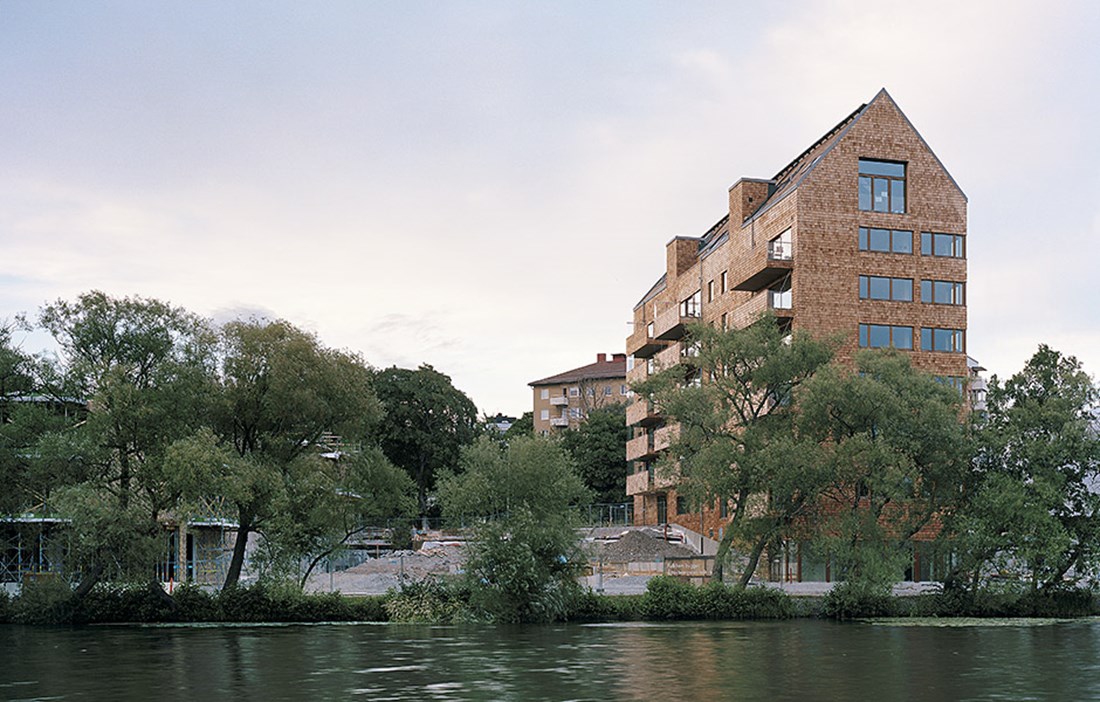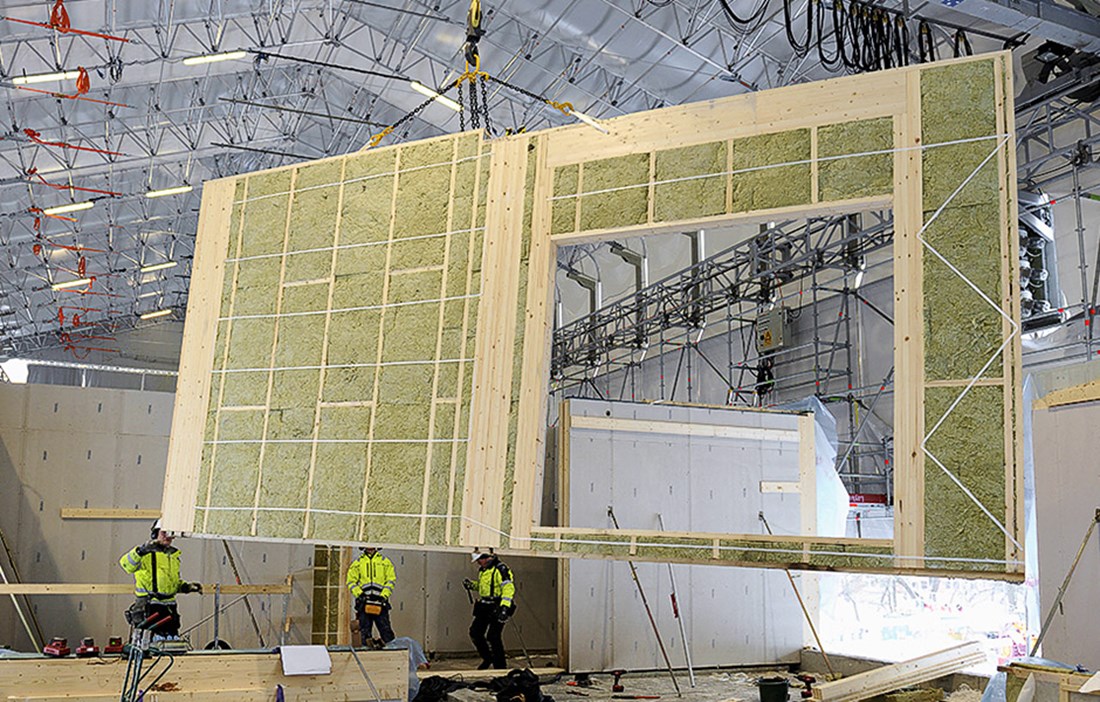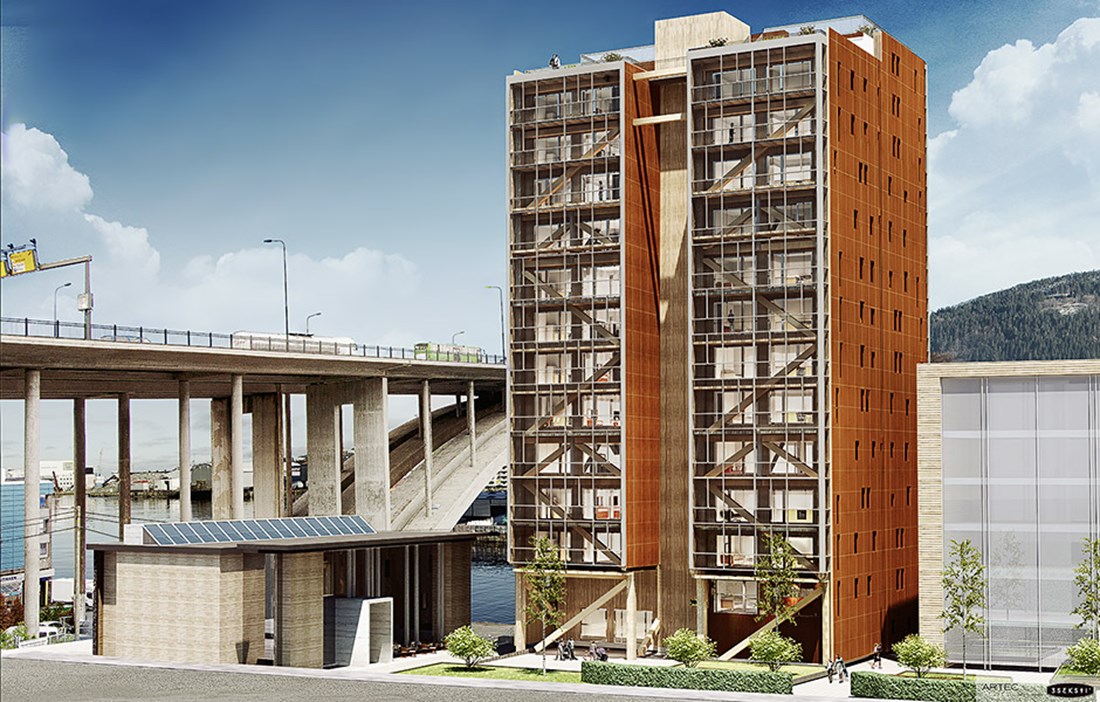THE GENTLE SCENT from the cedar facade as it warms in the morning sun is expected. The wood block floor in the stairwell is a surprise. But the dizziness is breathtaking. From the duplex apartment below the pitched roof in the first of Folkhem’s four eight-storey blocks in Strandparken, Sundbyberg, designed by Wingårdhs Arkitektkontor, the eye is drawn past a glass balcony, accelerates along 26 metres of shingled facade and continues straight down into Bällstaviken below.
People are currently moving into the building, which is the tallest timber-framed block in the Stockholm area. The environmental profile was always a key element of the project, right from the very start – the buildings were to be built in timber, and the wood was to be clearly on show. The facade is clad in knot-free cedar shingles, a choice that came after a great deal of debate about the right solution.
“Resolving the details of a facade as large as this requires a whole new set of rules. It would perhaps seem obvious to go for the usual smooth cladding, but there’s quite a difference between a summer cottage and a high-rise block,” says Hanna Samuelson from Wingårdhs, who has worked on the project along with others such as lead architect Anna Höglund and engineer Anders Stålberg from the same office.
Hanna Samuelson lists some of the challenges they faced in erecting the building. What do you do about joints? Capillary effect? And maintenance? What tenant owners’ association wants to be up oiling the exterior walls every five years?
“We have to take the wood seriously, it has to breathe, it absorbs water, it shrinks and swells and it moves,” she explains, stressing that the material has to be seen differently from the design program’s abstract, shiny surfaces that rise up to whatever height without any concerns.
The solution was cedar shingles, which are naturally resistant to rot and fungus and do not require treating. The trick is that all the small individual details give the facade a sort of pixelated effect that is less sensitive to variation. Each shingle can vary incredibly in colour – starting off dark red, or sometimes brown, and gradually turning grey – without the facade as a whole looking patchy or blotchy. The idea is that it will still look good 10, 15 or 30 years from now.
Although the structural frame is not exposed in the interior, surfaces in natural materials have been a guiding principle. The material palette for everything from ceilings to elevator interiors is made up entirely of carefully chosen woods. The internal window surrounds and the floor are ash, the balcony parapets are cedar and the window frames are stained pine. The wood can be both seen and touched, giving the new residents the natural feel they want. And they get good air quality into the bargain.
“No emissions from plastics and laminates or spores flying around. And the building is dry from the outset, so there is no integral damp to cause problems,” states Hanna Samuelson.
ALTHOUGH BUILDING HIGH-RISE blocks in timber has been permitted in Sweden for almost 20 years now, questions from prospective buyers and visitors about the material choice in Strandparken often tend to come around to fire.
“I usually offer matches to all the visitors, so they can give it a try,” says Arne Olsson, CEO of the developer Folkhem, as he points to the exposed timber frame in the showroom.
Setting fire to 170 millimetre cross-laminated timber is like trying to light up a tree trunk. Arne points out that what burns quickly and is dangerous in an apartment is the interior furnishings, no matter what the building is made from.
For many it is a reflex action conjured up by images of charred remains. Maybe this is because a steel girder twisted in the heat is an uncommon sight compared with a burning piece of wood. In contrast to steel, wood behaves predictably in a fire, which makes it easy to get the specifications right and safer for the fire service to go in if an emergency does arise. The firemen can quickly see more or less how long a timber-framed building will stay standing, even if it is on fire. The charred surface that forms at high temperatures on a load-bearing timber beam or post protects the material inside. The structural frame is therefore designed according to the length of time the building has to stand for under fire regulations. It must be possible for several centimetres to become charred without the structure losing its load-bearing capacity.
The apartments in Strandparken are fitted with domestic sprinklers, as an extra safety measure. In the event of a facade fire, the system cools both the rooms and the windowpanes to protect against any external heat. Wingårdhs architect Hanna Samuelson again:
“There’s a lot of psychology in this. Everyone knows that wood burns. But then what happens to a facade of cellular plastic covered with a thin layer of render?”
THE CLT SURFACE UNITS from which the building is constructed were supplied by the Martinsons factory in Västerbotten. They are one storey high and as wide as one apartment.
“The risk with a prefab building is that it looks like a patchwork quilt with all its joints. The great thing about the shingles is that we can attach them to the wall units in advance and then sort out the horizontal and vertical joints once they are up,” says Hanna Samuelson.
On closer inspection, the precision is impressive. Row after row of neat shingles wrap around the building. They line up with the windows, come out onto the balcony parapets and reach over the pitched roof, and in the corners they meet like the fingers on a pair of clasped hands – which is exactly as it should be. Developer Folkhem has always had high environmental ambitions for the project.
“What we thought was: If we put up timber-framed buildings and can make a name for ourselves as truly environmental builders in this city, we might be able to source land more easily and successfully. After all, isn’t every politician interested in doing their bit on climate issues?” says Arne Olsson.
“A building like this stores as much carbon dioxide as 40 concrete buildings. That’s why we see no need for any more debate on what construction materials to use.”
THAT ATTITUDE HAS NOT been quite so prevalent in other high-rise timber projects, not even high-profile ones. A prime example is when architects at Waugh Thistleton tried to sell their design for a nine-storey block in solid timber in Murray Grove, London, to their client. They highlighted the environmental advantages of wood and the accompanying PR coup, but the argument fell on deaf ears. The fact that the material would reduce carbon emissions by over 300 tonnes compared with an equivalent building in concrete was not a viable argument in the property market, countered the client, because who wants to pay London prices to live in an ‘experiment’? Then the architects explained that the Austrian solid timber frame could be delivered on about 20 lorries and erected at a rate of one storey per week. This was an argument the client could buy, but with one ultimatum: that the choice of material would be kept secret when the apartments were released onto the market.
The interiors were clad in plasterboard and the outside of the timber building was concealed behind a facade of fibre cement panels. However, news of the impressive timber design was leaked to the press and once published, all 29 apartments sold in just one and a half hours.
In a suburb of Milan, the cranes have recently left the continent’s largest timber construction site. The four residential high-rises were designed by RossiProdi Associati and are connected by two-storey terraces that form enclosed courtyards. Together they form the new housing complex Via Cenni.
The project is part of the reconstruction process after the massive earthquake in L’Aquila in 2009. The load-bearing walls, floor structure and elevator shafts of the buildings have been constructed in cross-laminated timber totalling 6,000 m. The choice of wood partly came down to a question of time, since it was important to replace damaged and condemned buildings across the region as quickly as possible.
Making sure the disaster would not be repeated was also an important priority when choosing wood as a construction material. The timber-framed design is estimated to weigh around a quarter of the equivalent building in concrete, which means that if some part of the building were to collapse, the damage and injuries would be less severe. Even more importantly, the lower mass reduces the forces that build up when the ground shakes, which makes the building much better protected against future earthquakes.
ON WAGRAMERSTRASSE IN VIENNA Austria’s tallest residential timber building has just been handed over to its tenants. The block is seven storeys high and was designed by Schluder Architektur.
At the same time, a new building is being constructed to house the Wood Innovation Design Centre in British Columbia, Canada, providing offices and public spaces. This one, by architects mga, is likely to be the world’s tallest timber-framed design. But that is not likely to remain the case for long – even the architects hope the record will soon be beaten.
Perhaps that will happen in Bergen, Norway, where the green light has just been given for the residential tower ‘Treet’ which, at 14 storeys, will lay claim to the title of ‘tallest timber-framed building in the world. The project was designed by Marina Trifkovi and Per Reigstad from the Artec firm of architects and is described as groundbreaking with its combination of load-bearing glulam and modules. It will be 47 metres tall and should be ready to move into by early autumn 2014.
The US architectural giant Skidmore, Owings & Merrill, which designed the Burj Khalifa and five more of the world’s 12 tallest buildings, also recently published a research report on a system for timber skyscrapers. The report describes the timber construction technique as an evolution of the formula from the past century for tall office blocks in steel and glass that once set the standard. And London-based Arup, often referred to as the world’s leading consulting engineers, have also just tackled the issue of tall timber buildings with a fresh high-rise concept called the Life Cycle Tower.
100 years ago, 10 floors of cast iron or concrete would scare passers-by, who were convinced the building was going to fall down on them, but high-rises soon became an established part of the cityscape. Similarly, timber high-rises are becoming more accepted as they become more common. As the push for altitude escalates, more and more applications are also coming to light.
BACK AT STRANDPARKEN in Sundbyberg, a removals van has just pulled up outside the door. Storage boxes share the elevator with tradesmen on their way up to put the finishing touches to the interior in the duplex apartment in the pitched roof. Before the final finishes are applied, it is still possible to see how all the installations fit into the floor structure and how the heating coils are channelled under the floor. No radiators, so the large, sliding patio doors go all the way down to the floor.
For optimum sound insulation, the ceiling is suspended from the walls, not from the floor structure above, and the walls separating the apartments are made from double solid wood panels separated by a 20 mm air gap. Each apartment becomes a separate acoustic box.
Folkhem’s tall, thin block is the first of a group of seven to be completed, all of which will have one gable overlooking the waterside promenade along Bällstaviken and the other facing Sundbyberg’s Hamngatan. The four middle blocks will be timber buildings with a similar design to the first one. These will be flanked by prefabricated concrete buildings constructed by another developer.
New residents therefore have a building site on either side of them, but they are each quite different: From the north side comes the screaming of a grinder on a concrete section and its reinforcement bars. On the south side, a huge white marquee stands ready to follow the next new timber building, step by step, as it grows up from the ground. Inside the marquee it is quiet and dry.
“And it smells of freshly sawn timber,” says Hanna Samuelson.
Text Björn Ehrlemark























